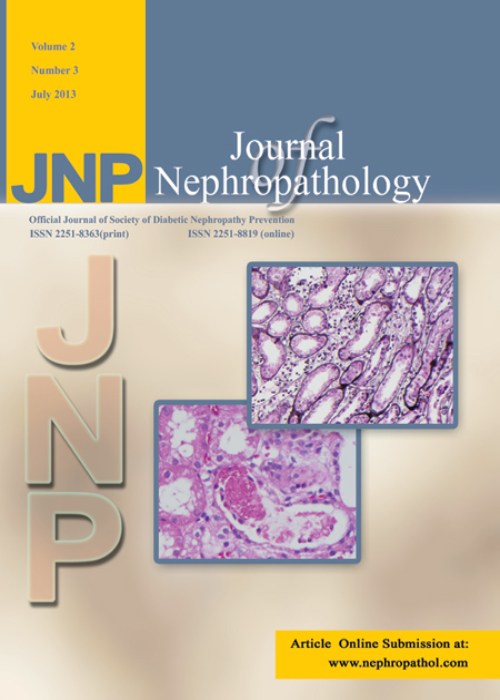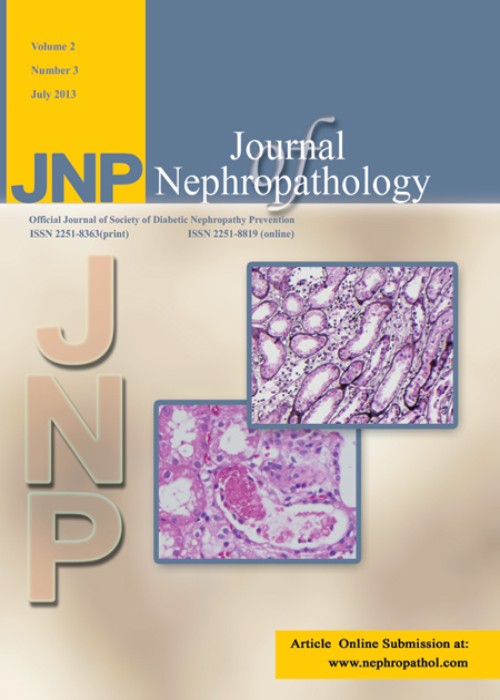فهرست مطالب

Journal of nephropathology
Volume:12 Issue: 4, Oct 2023
- تاریخ انتشار: 1402/07/09
- تعداد عناوین: 11
-
Page 1
IgA nephropathy is a common glomerulonephritis with variable clinical outcomes. The optimal treatment for this condition remains uncertain, and corticosteroid therapy is reserved for patients unresponsive to supportive treatment. The histopathologic examination has a significant role in the diagnosis and prognosis of IgA nephropathy, but its role in the initiation of corticosteroid therapy is still under debate. Recently, targeted release formulation (TRF)-budesonide has emerged as a promising treatment due to its localized delivery to the gut and low systemic adverse effects. This brief review aims to assess recent advancements in IgA nephropathy management, focusing on applying Oxford classification in guiding corticosteroid therapy.
Keywords: IgA nephropathy, Targeted-release budesonide, Corticosteroid, Oxford classification, MEST-C score -
Page 2
The incidence of urothelial carcinoma is increasing worldwide (including in Iran). Bladder cancer can be classified in various manners according to the standardized histomorphology set by the World Health Organization (WHO). Various genetic modifications occurring at the DNA level and the resulting variations in RNA expression give rise to different subcategories that have important implications for diagnosis, prognosis, and treatment. The molecular basis of these morphologic variances is now better understood because of recent developments in molecular biology. With updates on the genetic and clinical characteristics, we highlight the histologic traits of the divergent differentiation and subtypes recognized by the most recent WHO classification (5th edition). Molecular subtypes of lower and upper tract cancer can be used to characterize their clinical behaviors and determine therapeutic responses to neoadjuvant chemotherapy. In this overview article, we also present a preliminary analysis of our ongoing data collection on molecular features of urothelial carcinoma.
Keywords: Bladder cancer, Urothelial carcinoma, Lower tract urothelial carcinoma, Upper tract urothelial carcinoma -
Page 3
Hypertension (HTN) is the most prevalent chronic non-infected disease and the greatest cause of adult premature mortality. Although in the past clinicians assumed that HTN in childhood and adolescents is uncommon, it is currently a significant public health issue and this narrative review aimed to assess the new finding regarding screening for HTN in Children and adolescents. Relevant English publications were extracted from Web of Science, PubMed, Scopus, and Google Scholar. As there are gaps regarding recommendations, guidelines, and screening for HTN in children and adolescents, this review tried to notice some important points.
Keywords: Hypertension, Blood pressure, Child, Adolescents, Screening -
Page 4
This study investigates the role of bile cast nephropathy (BCN) in acute kidney injury associated with cholestatic liver disease. Bile cast nephropathy is characterized by kidney injury due to, bilerelated factors, distinct from hepatorenal syndrome (HRS) linked to hemodynamic changes in liver disease. The mechanisms of BCN include oxidative damage, tubular toxicity, and obstructive physiology. Diagnosis is typically through biopsy, although alternatives like trans-jugular biopsy are considered due to bleeding risks. Treatment targets underlying causes of hyperbilirubinemia, and extracorporeal therapies like plasmapheresis and molecular adsorbent recycling system show potential efficacy. Awareness and further research on noninvasive diagnostic methods for BCN are recommended.
Keywords: Bile cast, Nephropathy, Hepatorenalsyndrome, Cholemic nephrosis, Jaundice associated nephropathy, Acute kidney injury -
Page 6Introduction
Sodium-glucose cotransporter-2 (SGLT2) inhibitors are a new diabetes treatment. Considering the prescription of these medicines for kidney transplant patients, this systematic review and meta-analysis aimed to investigate the impact of SGLT2 inhibitors on kidney transplant patients.
Material and MethodsThis meta-analysis study was performed based on the PRISMA guideline. The necessary data were collected by searching the databases of Scopus, PubMed, Cochrane, Google Scholar search engine, and Web of Science without a time limit until March 1, 2023. The data were analyzed in STATA 14. A P value less than 0.05 was considered significant.
ResultsThe authors assessed eight articles with a sample size of 960 patients. The SGLT2 inhibitors showed no significant impact on levels of estimated glomerular filtration rate [SMD: -0.21 (95% CI: -0.65, 0.25)], serum creatinine [SMD: -0.02 (95% CI: -0.19, 0.15)], plasma hemoglobin A1c (HbA1c) [SMD: -0.62 (95% CI: -1.43, 0.18)], systolic blood pressure [SMD: -0.64 (95% CI: -1.80, 0.52)], and diastolic blood pressure [SMD: -0.64 (95% CI: -1.41, 0.14)], and on the patient’s weight [SMD:-0.31 (95% CI: -0.80, 0.18)]. Patient age did not influence the impact of SGLT2 inhibitors on estimated glomerular filtration rate (50–59 years-old age group: [SMD: 0.13 (95% CI: -0.04, 0.30)], 60–69 years-old age group: [SMD: -0.56 (95 % CI: -1.38, 0.26]). Duration of medicine use did not affect the impact of SGLT2 inhibitors on estimated glomerular filtration rate [6 months after medicine use: SMD: -0.56 (95% CI: -1.38, 0.26)], 12 months after medicine use: [SMD: 0.10 (95% CI: -0.05, 0.26)].
ConclusionSGLT2 inhibitors were not effective in lowering blood pressure, estimated glomerular filtration rate, serum creatinine, and hemoglobin A1c levels, or weight in kidney transplant patients. Although SGLT2 inhibitors were ineffective in improving kidney transplant patients’ renal function, there were no side effects, and the administration of this drug in kidney transplant patients can continue. Further research is required to ensure safety and determine the appropriate dosage and duration of drug use.
Registration:
The study was compiled according to the PRISMA checklist and its protocol was registered on the PROSPERO (ID: CRD42023407501) and Research Registry (UIN: reviewregistry1666) websites.
Keywords: Diabetes mellitus, Sodium-glucose cotransporter two protein, Human, SGLT2 protein, Dapagliflozin, Canagliflozin, Empagliflozin, Kidney transplantation, Renal transplantation -
Page 7Introduction
Patients with chronic kidney disease (CKD) have increasingly been diagnosed with cognitive impairment. Glycogen synthase kinase 3β (GSK3β) is directly causing both phosphorylated tau (pTau) and amyloid β (Aβ) accumulation in Alzheimer’s disease (AD). GSK3β expression is more abundant in human platelets than in other blood cells. Recombinant human erythropoietin (rHuEPO) is a common medicine for treating anemia in patients with CKD, as well as a neuroprotective agent.
ObjectivesThe goal of this research is to find out how platelet GSK3β regulates plasma Aβ, total Tau and tau phosphorylated at threonine 181 (p-tau181) levels in CKD patients with cognitive dysfunction and also the efficacy of rHuEPO treatment. Patients and
MethodsThe study included 60 participants, which consist of 30 CKD without cognitive dysfunction and 30 CKD with cognitive dysfunction based on the neuropsychological examination. The expression of GSK3β in platelets was evaluated using a western blot and plasma Aβ, total Tau, pTau 181 levels were quantified by ELISA. The data were compared statistically (P < 0.05) to AD, normocytic normochromic anemic and healthy patients.
ResultsIn CKD with cognitive dysfunction subjects, platelet GSK3β expression and plasma Aβ, total Tau and pTau181 levels were significantly (P < 0.05) altered like AD when compared to normocytic normochromic anemic, healthy and CKD without cognitive dysfunction subjects. In post rHuEPO (100 IU/kg, weekly twice, six months) treatment, the altered protein abnormalities were retrieved significantly (P < 0.05) compared to pre-treatment.
ConclusionThis study established that platelet GSK3β expression and plasma Aβ, total Tau, pTau181 are the candidate biomarkers for cognitive dysfunction in CKD patients. The clinical utility of rHuEPO as a GSK3β inhibitor and therapeutic agent for cognitive dysfunction in CKD has been determined.
Keywords: Chronic kidney disease, Cognitive impairment, Aβ, Tau protein, GSK3β, Recombinant human erythropoietin -
Page 8Introduction
Uremic pruritus is a common discomfort in end-stage renal disease patients on long-term hemodialysis. It negatively affects patients’ quality of life and is associated with increased mortality. The pathogenesis of uremic pruritus is complex. Aluminum is a toxic metal and common human allergen that causes an immune reaction in patients on hemodialysis. Aluminum is hypothesized to play a vital role in the pathogenesis of uremic pruritus. Controlling serum aluminum levels is still critical for patients on long-term hemodialysis.
ObjectivesTo determine the prevalence of hyperaluminemia and assess its correlation with uremic pruritus in patients on long-term hemodialysis.
Patients and MethodsWe conducted a case-control study on 90 patients on long-term hemodialysis at the dialysis units of Ain Shams university hospitals. We used the 5-D itch scale numerical rating system to determine the presence and severity of pruritus in our study participants. We collected blood samples to estimate blood urea nitrogen levels pre- and post-dialysis, as well as the measured urea reduction ratio, serum creatinine, hemoglobin level, intact parathyroid hormone, ionized calcium, serum phosphate levels, iron study and serum aluminum levels.
ResultsOur study showed no statistically significant differences between the pruritic and nonpruritic study groups (median values 9.78 [6.48–11.72] and 9.13 [6.3–10.4] for the pruritic and non-pruritic groups, respectively; P = 0.32).
ConclusionThe serum aluminum levels of our study participants were higher than the normal levels in humans. Patients in the pruritic group had higher levels than those in the non-pruritic group. However, aluminum levels were not significantly associated with either the presence or severity of pruritus in patients on long-term hemodialysis.
Keywords: Uremic pruritus, Aluminum, 5D-itch scale, End-stage renal disease -
Page 9Introduction
Alpha-cypermethrin is a pyrethroid insecticide. Chronic exposure to alphacypermethrin is mainly due to the usage in household pest control or through drinking water and contaminated fruits and vegetables. The kidneys are considered as an essential organ in human and animal bodies. One of the causes of nephrotoxicity is exposure to environmental pollutants.
ObjectivesThe present study was designed to investigate the deleterious effects of alpha-cypermethrin when administered in two doses in the kidney tissues of mice.
Patients and MethodsThe kidneys of treated and control mice were removed and fixed in 10% neutral buffered formalin. Subsequently, the specimens were passed by a series of concentrations of ethyl alcohol and embedded in paraffin and finally stained with hematoxylin and eosin.
ResultsTreated mice groups are being investigated with several histopathological changes in their kidney tissues even at low-concentration of dose. These changes varied in males and female laboratory mice. These effects included bleeding, congestion, edema, aggregation of fat cells in various sizes and inflammation and death renal cells. Additionally, vacuolization of cytoplasm, necrosis, loss of glomeruli, shrinkage of tubular cell nuclei, necrosis of some tubular cells, enlargement or death of these cells, congestion and dilation Bowman’s space, hemorrhage and hyperplasia of cells were also existed.
ConclusionThis research confirmed that alpha-cypermethrin causes severe deterioration in kidney tissues of Swiss albino mice.
Keywords: Alpha-cypermethrin, Swiss mice, Kidney, Histopathology, Pesticides -
Page 10
Immune checkpoint inhibitors (ICIs) constitute a class of drugs that stimulate the immune system to fight cancer cells. However, they can also induce immune-related adverse events (irAEs) in various organs, including the kidneys. One of the infrequent irAEs associated with ICIs is sarcoidosis, an inflammatory disease that can impact multiple organs, such as the lungs, skin, and lymph nodes. Sarcoidosis is characterized by the formation of granulomas, clusters of immune cells that can potentially harm tissues. In some cases, ICIs can trigger kidney sarcoidosis, leading to impaired renal function. The mechanism through which ICIs initiate sarcoidosis is believed to involve activating T cells and cytokines that foster inflammation.
Keywords: Immune checkpoint inhibitors, Renalsarcoidosis-like reaction, Sarcoidosis, Immune-related adverse events, Immune checkpoint inhibitorassociatedsarcoidosis, Granulomas


